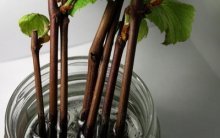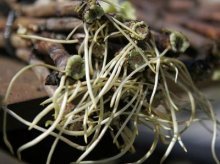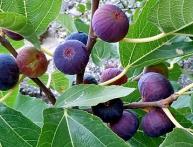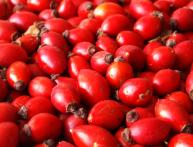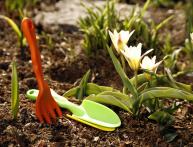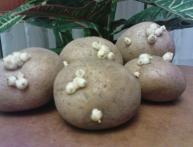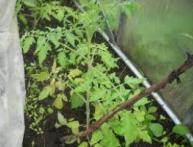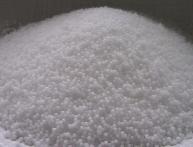Proper cultivation of grapes from chibouks
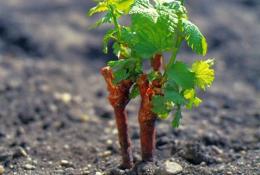
Having your own plot of land, it is difficult to deny yourself the pleasure of feasting on amber grapes. Germinating grape cuttings may seem simple, but carelessness in the little things can ruin the result of many days of work and anticipation.
Content:
Preparation of planting material
Chubuki (cuttings of a one-year-old fruit-bearing vine) are prepared in early autumn: short shoots of the upper part of a healthy vine are cut off. The cuttings are cut obliquely with a sharp and always clean knife to avoid infection.
Storage is also very important. As a rule, the cuttings are washed with cold water, wrapped in thick polyethylene and put in the refrigerator. The optimal storage temperature is from 0 to +5`С. It is often recommended to simply sprinkle the pipes with damp sand, but make sure that mold does not form.
In order for the chibouks to germinate and subsequently produce good harvest you need to choose them carefully. The following parameters have meaning:
- The correct color of shank for germination is green. The cuttings should not have dark spots, rot or any damage.
- The width of the shank should not exceed 8 mm. The length is more difficult: it varies from 12 to 60 cm. A shoot that is too short will not have enough strength to germinate, and stems that are too long are stored worse.
- Chubuk should have 2-3 healthy buds. The cut must be smooth and always dry.
Healthy and properly processed chibouks will keeps well, and will also give a rich harvest.
Germination of chibouks
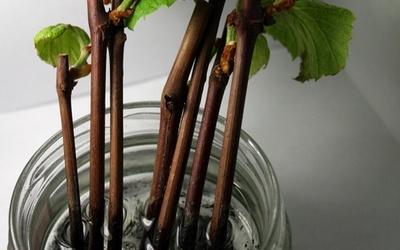
At the beginning of April, the chubuks are taken out of storage and prepared for germination. To do this, they are washed in cold water and disinfected with manganese, a process that takes 6 hours.
After this, the sections are renewed by 2 mm and the pipes are soaked in melted or simply settled water for 1-2 days. To stimulate the development of the root system, you can add rootin, heteroauxin, epin, charkor or something similar to the water. About 1/3 of the cutting should be in water. The upper part can be greased with garden varnish.
For best results, it is recommended to use keeled chibouks. You can make a kilchevator yourself from a plastic bottle and sawdust soaked in a manganese solution.
You can also make shallow notches on the bottom of the cutting to stimulate root growth.
Instead of a kilcher, you can simply take plastic or paper cups. If you take transparent cups and remove the bottom, it will be easier to observe the process.
Cups are filled garden soil with the addition of sand and humus (3:1:1). After planting, the cuttings are placed in a warm, shaded place where there are no drafts. It is necessary to water the chibuki only with warm, settled water, and also do not forget to regularly loosen the soil.
If all conditions are met, after three weeks healthy roots will form on the heels of the chibouks. After 2 weeks, some winegrowers recommend hardening the shoots by taking them out into the fresh air.
Seedling care
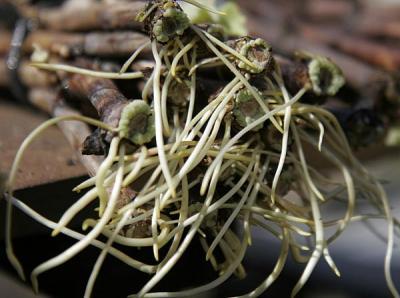
Disembarkation
When the grown roots reach a length of 2 cm, they can be planted in pots with specially prepared soil. There must be a drainage layer at the bottom of the container, at least 3 cm wide.In prepared pots, the chibuki are taken out “for long walks” and then for permanent stay. There is no need to rush, because grape seedlings very sensitive to temperature changes.
Top dressing
Chubuki need fertilizer and mandatory loosening of the soil. Mineral fertilizers are extremely important for the good development of the vine. They can be applied either into the soil itself or together with irrigation water. While maintaining the required soil moisture, the water in pots with chibouks should never stagnate. This will lead to the death of seedlings.
Landing at a permanent place
Sprouted chibuki are planted around mid-summer - when it finally gets warmer. The slightest frost will destroy the root system and your work will be lost. When planting, you should be very careful not to damage the roots.
Stronger and greener chibuki also require regular loosening, warm watering and application to the soil. mineral fertilizers. A weak solution of honey (1 tablespoon per 10 liters of water) will help strengthen the root system. As a rule, by autumn a vine that has grown to 2 meters has strong roots and several healthy branches.
As for the planting location, it all depends on the grape variety. You should not get carried away with the exotic; it is better to choose grapes from local varieties, then the harvest will not disappoint.
Any plant requires attention and care. By observing all the conditions of the technology for germination and growing grapes, you can get a fairly rich harvest even in the middle zone.
Watch how to grow grapes from chibouks in the video:
Interesting information about the vegetable garden

